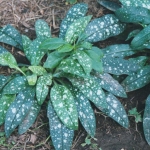| Common Name: |
Common Lungwort |
| Other Names: |
Jerusalem Cowslip, Jerusalem Sage, Lungs of Oak, Lungwort, Soldiers and Sailors |
| Botanical Name: |
Pulmonaria offinalis |
| Genus: |
Pulmonaria |
| Family: |
Boraginaceae |
| Location: |
Europe |
| Cultivation: |
Moist soil, including clay, in sun or shade. Sawfly larvae, slugs, and snails may attack foliage. Prone to powdery mildew in dry conditions. |
| Propagation: |
By seed sown when ripe; by division in spring immediately after flowering, or in autumn; by root cuttings in mid-winter. Germination may be slow. |
| Harvest: |
Plants are cut in early summer, and dried for infusions and extracts. |
| Height: |
25cm (10in) |
| Width: |
45cm (18in)or more |
| Variations: |
Cambridge Blue Group
Has eggshell-blue flowers, opening from pink buds.
Height: 30cm (12in) |
White Wings
Has pink-centered white flowers in late spring. |
|
| Hardiness: |
Z3-9 |
| Parts Used: |
Leaves |
| Properties: |
A soothing, astringent, expectorant herb. |
| Medicinal Uses: |
Internally for coughs, bronchitis, asthma, mucus, hemorrhoids, and diarrhea. Combines well with Marrubium vulgare (See, Horehound) and Tussilago farfara (See, Coltsfoot) for coughs in tuberculosis, and with Ephedra spp. (See, Joint Fir) for obstructed airways. Externally for wounds and as an eyewash.
To treat respiratory congestion, cough, diarrhea, various urinary and gastrointestinal tract ailments and wounds. |
| Typical Dose: |
A typical dose of lungwort has not been established. |
| Possible Side Effects: |
Lungwort's side effects include nausea, lack of appetite, and an increased tendency toward bleeding. |
| Drug Interactions: |
| Taking lungwort with these drugs may increase the risk of bleeding and bruising: |
| Aminosalicylic Acid, (Nemasol Sodium, Paser) |
Antithrombin III, (Thrombate III) |
Argatroban, (Argatroban) |
Aspirin, (Bufferin, Ecotrin) |
| Bivalirudin, (Angiomax) |
Choline Magnesium Trisalicylate, (Trilisate) |
Choline Salicylate, (Teejel) |
Dalteparin, (Fragmin) |
| Danaparoid, (Orgaran) |
Enoxaparin, (Lovenox) |
Fondaparinux, (Arixtra) |
Heparin, (Hepalean, Hep-Lock) |
| Lepirudin, (Refludan) |
Salsalate, (Amgesic, Salflex) |
Tinzaparin, (Innohep) |
Warfarin, (Coumadin, Jantoven) |
|
| Culinary Uses: |
Young leaves are added to salads and soups. |
| Economic Uses: |
Extract is an ingredient of vermouth |
| Warning: |
Skin irritant and allergen.
This herb is subject to legal restrictions in some countries. |
| Bibliography: |
Encylopedia of Herbs by Deni Brown Copyright ©: 1995, 2001 Dorling Kindersley Limited pp.336-337
The Essential Herb-Drug-Vitamin Interaction Guide by Geo. T. Grossberg,MD and Barry Fox,PhD Copyright©2007 Barry Fox,PhD Pg. 317 |
